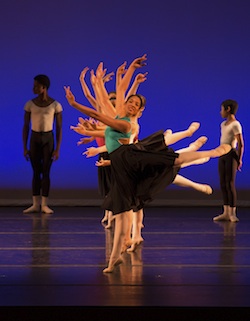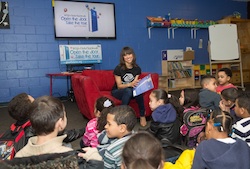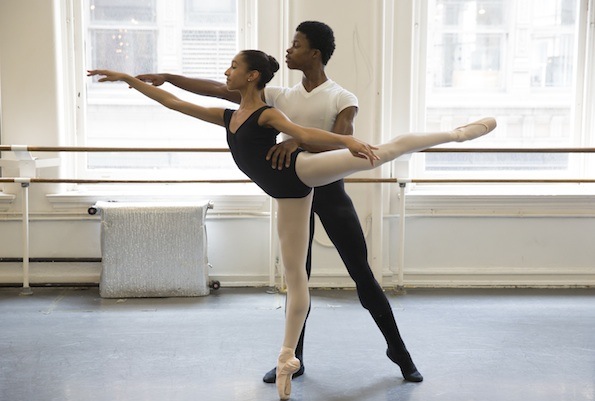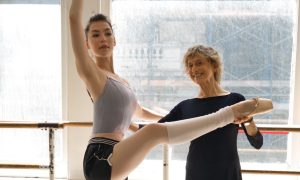By Chelsea Thomas of Dance Informa.
As American Ballet Theatre celebrates its 75th anniversary in the 2014-15 season, it will also be celebrating a newer milestone – the first birthday of Project Plié, its national initiative focusing on increasing racial and ethnic representation in ballet.
For a country known to be a melting pot of races, ethnicities and ancestral legacies, ballet is still incredibly streamlined, with nearly every major ballet company being made up mostly of Caucasian dancers. As dance critic Gia Kourlas asked in 2008, where are the black swans? And further more, where are the Latino and Arabian dancers?
Project Plié seeks to combat this issue of deficient racial diversity through a number of avenues – dance scholarships for nonwhite dancers, complimentary training for teachers of color or for teachers who work with ethnically diverse populations, partner companies around the country who strategize to reach their specific populations, free classes for kids through Boys & Girls Clubs of America, administrative internships for aspiring arts professionals of color, and master classes that introduce youth to ABT in each of New York City’s five boroughs.
“In launching Project Plié, American Ballet Theatre aims to take an important step toward helping the classical ballet profession better reflect the multicultural and ethnic diversity of our country’s population,” said ABT’s CEO Rachel S. Moore at the launch of the project in September 2013. “This initiative can assist ballet students from diverse backgrounds in reaching their full potential by providing them with the support and active engagement of teachers, mentors and current professional dancers. We sincerely believe that diversifying the art form at its training level will strengthen and broaden the pipeline of future artists and help ensure ballet’s continued relevance in the 21st century.”

Photo by Rosalie O’Connor.
Now, nearly a year later, Moore opened up with Dance Informa on how the project is going and how the ballet world has responded.
“It’s been extremely well received, which has been wonderful. People have really embraced the mission of the program and reached out to get involved. We’ve gotten a lot of positive feedback,” she said.
Since the project began, there has already been a rise in the number of dancers of color who have auditioned for ABT’s summer and year-round programs. According to Moore, there has been a five percent increase, which is “huge” because just for ABT’s summer program alone more than 5,000 kids on average audition. “So that’s a lot of kids who are feeling that they are supported and welcomed at ABT and we are really excited about that,” Moore said. In addition, ABT has been able to award 40 merit-based scholarships and housing stipends in the first year of the program for talented students of color.
Project Plié, which also seeks to recruit and train teachers, was able to provide six teachers National Training Curriculum scholarships, giving them the means to travel to New York, train with ABT’s NTC Director and learn to creatively and collaboratively address barriers to young dancers’ participation in their communities. These teachers came from far and wide, including: the Lula Washington Dance Theater in Los Angeles, CA; the Arabesque Dance Academy in Cincinnati, OH; The Dance Institute of Washington in Washington, DC; the Nomel Inspirational Dance Theater/Ohio Black Dance Festival in Columbus, OH; and the New Mexico School for the Arts and Keshet Dance Company, both in New Mexico.
As part of ABT’s effort to increase the dialogue about diversifying America’s ballet companies, it has established partnerships with professional companies around the United States. Current partner companies include: Ballet Austin, Ballet Memphis, Ballet San Jose, Nashville Ballet, Cincinnati Ballet, Oklahoma City Ballet, Orlando Ballet, Richmond Ballet and Washington Ballet. These partners will collaborate on the identification and development of effective strategies for working with communities of color. They’ll also strive to create a mentoring network for professional dancers and teachers of color to share information on professional opportunities.

Photo by Rosalie O’Connor.
“As the word got out about this facet of Project Plié, people who care about this really wanted to get involved and have colleagues to talk to and strategize with. This work can be very isolating sometimes as you are engrossed in your own community and you feel like you’re the only one doing the work. So it’s supportive to have people to talk to about it and be a part of a nationwide network of people who care,” Moore said.
One partner, Cincinnati Ballet, is one example of a company that was already seeking to reach its local underrepresented ethnicities. Julie Sunderland, director of education at Cincinnati Ballet, said the company is in its 18th year of the Cincy Dance! Program, which reaches over 1,000 under-served students per year. So it was an obvious choice for the company to partner with Project Plié.
“Cincinnati Ballet is dedicated to connecting to the community through dance, fostering diversity in all of our dancers and creating the audience of the future. We are so grateful to partner with ABT and follow them on this important journey,” Sunderland said.
Another partner company, Nashville Ballet, was also a natural choice for Project Plié. The ensemble frequently reaches out to its local population through its educational outreach programs, and by working closely with schools, community centers and service organizations throughout Middle Tennessee.
“We present interactive children’s ballet performances, conduct core curriculum based movement classes and give tickets to our full-scale performances in order to expose people to ballet who might not otherwise have the opportunity. We also created a scholarship program in our school for talented children we have identified through our outreach projects,” said Sharyn Mahoney, director of artistic operations.
Mahoney added, “Our hope would be that our community begins to see ballet as an inclusive art form that can be enjoyed by everyone, no matter your background, whether through watching, training or creating. As individuals from our community are affected by art, they return to the community a different person and spread that change. The possibilities are endless!”
Likewise, The Washington Ballet partnered with Project Plié because “the company has been focusing on this work for the past 20 years,” said Katrina Toews, director of The Washington Ballet at THEARC.
“We are connecting with children in our public school program, DanceDC, which allows boys and girls the opportunity to try dance and understand pre-ballet movements. This allows us to create a positive pipeline from public school to our scholarship program, EXCEL!, and then to remain in the school, elevate to the pre-professional training group, audition for The Washington Ballet Studio Company and then get into the company,” Toews said.

Misty Copeland with kids from the Boys & Girls Clubs of America. Photo courtesy of Boys & Girls Clubs of America.
In addition to partnering with these professional ballet companies, Project Plié includes a new partnership with Boys & Girls Clubs of America. ABT Soloist Misty Copeland is serving as an ambassador for the partnership, visiting different Boys & Girls Clubs across the nation.
“I believe we’re going into about 30 different Boys & Girls Clubs for this inaugural year for the program,” Moore said. “The goal is to introduce the world of ballet to kids who may have never known what it is or had any interest in it. The hour-long class is meant to tantalize them and draw them into dance. For the kids who stand out at as being exceptionally talented, we will work with their parents to be able to give them scholarships to further their training if that’s what they want.”
ABT, Cincinnati Ballet, Nashville Ballet and many others partner companies are implementing their first classes with Boys & Girls Clubs starting this month.
Overall, the long-term goals of the many outreach initiatives of Project Plié are to see America’s ballet companies diversify and begin to reflect the country’s multiculturalism.
“We recognize the demographics of this country are changing and that if we’re going to be relevant in the 21st century, then ballet needs to embrace and engage a broader public, both on and off stage,” Moore said. “So that’s really why we wanted to do this – we want ballet to be relevant and it can’t be if it’s relegated to one ethnicity or another.”
One exciting outcome of this program is the possibility of new voices being brought to the field, and with them, new ideas, innovations and expansions to the art form.
“I think that as we diversify our audiences and diversify our dancers it will change the art form in subtle ways that embrace many voices, which is critical to being relevant,” Moore noted.
For more information on Project Plié, visit www.abt.org/education/projectplie.
Photo (top) by Rosalie O’Connor.













